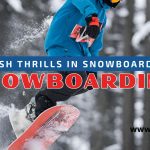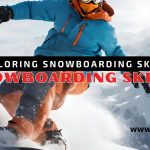Have you ever watched snowboarders gracefully gliding down the slopes, effortlessly navigating curves and performing impressive tricks? Do you dream of experiencing the thrill of this exhilarating winter sport but wonder if you can learn it on your own?
Contrary to popular belief, learning how to snowboard without formal instruction is not only possible but also an exciting challenge that many enthusiasts undertake. Whether you’re an independent learner seeking the freedom to progress at your own pace or simply prefer self-guided activities, teaching yourself how to snowboard can be a rewarding adventure.
In this article, we will delve into the world of self-taught snowboarding and explore valuable insights and tips for mastering this sport independently. By debunking common misconceptions and providing practical advice, you’ll gain the confidence to embark on your snowboarding journey without the need for formal education.
So, lace up your boots, grab your board, and join us as we uncover the secrets to becoming a self-taught snowboarding sensation!
Understanding the Basics of Snowboarding

When it comes to snowboarding, building a strong foundation of basic skills is crucial for beginners. This section will guide you through the fundamental concepts of snowboarding, providing you with the knowledge necessary to start mastering this exhilarating sport on your own. From understanding the equipment you’ll need to achieving the proper stance and balance, we’ve got you covered.
Gearing Up: Choosing the Right Equipment
Before hitting the slopes, it’s essential to have the right snowboarding gear. Invest in a well-fitted snowboard, boots, and bindings that cater to your skill level. Beginner-friendly boards are usually softer and more forgiving, making it easier to control your movements and learn the basics. Don’t forget to wear appropriate protective gear such as a helmet and wrist guards for added safety.
Finding Your Stance and Balance
Achieving the correct stance and balance is key to maintaining control and stability while snowboarding. There are two main stances to consider: regular (leading with your left foot forward) and goofy (leading with your right foot forward). Experiment with both stances and determine which feels more natural for you.
When it comes to balance, focus on distributing your weight evenly between both feet. This even weight distribution helps maintain stability and control, preventing you from leaning too far forward or backward. Keeping your knees slightly bent also improves your balance and allows for smoother movements on the slopes.
Mastering the Art of Edging and Turning
Learning how to edge and initiate turns is a fundamental skill every snowboarder should master. Edging refers to the process of applying pressure on your board’s edges to control your speed and direction. By leveraging the heel and toe edges of your board, you can carve through the snow and navigate various terrains effortlessly.
To initiate turns, shift your weight and pressure onto your front foot while angling your board in the desired direction. This weight shift, coupled with the proper movement of your hips and shoulders, will guide your board smoothly into the turn. Practicing these techniques on beginner-friendly slopes will help you gain confidence and improve your turning abilities.
Creating the Perfect Link from Turn to Turn
Linking turns is the key to fluid and seamless snowboarding. As you complete one turn, focus on transitioning smoothly into the next by maintaining balance and using the correct edge control technique. This continuous flow of turns allows you to maintain speed and control down the slopes, improving your overall snowboarding experience.
Regular practice and repetition of these basic snowboarding techniques will help solidify your foundation as a self-taught snowboarder. As you become more confident, you can then progress to more advanced skills and techniques.
Preparing Yourself Mentally and Physically
When embarking on a journey of self-guided snowboard training, it’s vital to prepare yourself both mentally and physically. The world of independent snowboarding instruction requires focus, determination, and the right mindset to overcome challenges and make progress.
Physical fitness plays a crucial role in snowboarding. It is essential to build strength, flexibility, and endurance to maximize your performance on the slopes. Incorporating exercises that target your core, lower body, and balance will significantly enhance your snowboarding abilities.
“Snowboarding demands a strong core, as it helps with stability, power transfer, and improved control on the snow.” – Professional snowboarder, Jane Wilson
Engaging in activities like yoga, pilates, and strength training exercises that focus on your legs, hips, and core will contribute to better balance, agility, and overall body control while snowboarding.
Equally important as the physical aspect is the mental preparation. Snowboarding requires mental resilience and a positive mindset. As you venture into self-taught snowboarding, it’s natural to face moments of frustration or self-doubt. Developing mental fortitude, perseverance, and a growth mindset will empower you to overcome obstacles and continue to improve.
“Believing in yourself and your abilities is half the battle won. Trust the process and embrace the learning journey.” – Snowboarding instructor, Alex Reed
Visualization techniques can be a valuable tool in mental preparation. Mentally rehearsing snowboarding movements and visualizing successful runs can improve muscle memory and boost confidence on the slopes.
Key Takeaways:
- Build physical fitness through strength, flexibility, and balance exercises to enhance your snowboarding performance.
- Cultivate mental resilience and a growth mindset to overcome challenges and stay motivated.
- Utilize visualization techniques to improve muscle memory and boost confidence while snowboarding.
| Physical Preparation | Mental Preparation |
|---|---|
| Build strength, flexibility, and endurance through exercises targeting the core, lower body, and balance. | Cultivate mental resilience, perseverance, and a growth mindset to overcome challenges. |
| Engage in activities like yoga, pilates, and strength training to enhance balance, agility, and body control. | Utilize visualization techniques to mentally rehearse movements and boost confidence on the slopes. |
Choosing the Right Terrain and Conditions

When learning snowboarding independently, one of the crucial factors to consider is selecting the right terrain and conditions. This ensures a safe and enjoyable experience, especially for beginners.
Choosing Suitable Slopes
Beginners should start with gentle slopes that offer a forgiving learning environment. Look for slopes marked with green or easy ratings, as these are specifically designed for novice riders. These slopes provide a gradual incline, allowing you to build confidence and practice essential skills without feeling overwhelmed.
It’s important to note that each mountain resort may have its own rating system, so familiarize yourself with the specific ratings used at your chosen resort.
“Starting on easier slopes is crucial for beginners to understand the basic techniques and gain confidence on the snowboard.” – Pro Snowboarder Jake Smith
Considering Weather and Snow Conditions
Weather and snow conditions significantly impact your snowboarding experience. Pay attention to weather forecasts, as certain conditions are more conducive to learning than others.
Ideal snowboarding conditions for beginners include:
- Freshly groomed slopes: These slopes have been mechanically smoothed, providing a firm and even surface for beginners to practice on.
- Soft snow: Powder or packed powder snow offers better control and stability, making it easier for beginners to initiate turns and maneuvers.
- Mild weather: Choosing days with moderate temperatures and good visibility will enhance your comfort and help you focus on learning without distractions.
“Being aware of weather and snow conditions ensures a positive learning experience. Smooth, soft, and mild conditions will make learning snowboarding more enjoyable and less challenging.” – Snow Sports Instructor Sarah Johnson
Finding the Right Time of Day
Another aspect to consider is the time of day when you plan to snowboard. Early morning or late afternoon sessions tend to be less crowded, providing more space and less traffic on the slopes. This is particularly beneficial for beginners as it reduces the chances of collisions and allows you to focus on your own progress.
Furthermore, choosing quieter times on the mountain can also provide a less intimidating environment for learners, allowing you to build your confidence at your own pace.
By choosing suitable slopes, considering weather and snow conditions, and finding the right time of day, you can create an optimal learning environment for teaching yourself how to snowboard. Remember to always prioritize safety and enjoy the journey as you progress in your snowboarding skills.
Learning and Practicing the Fundamental Skills

When it comes to teaching yourself how to snowboard, mastering the fundamental skills is crucial for building a strong foundation. By focusing on these essential techniques, you can develop the necessary confidence and control to navigate various terrains with ease.
Gaining Balance and Control
Keywords: self-learn snowboarding techniques, diy snowboarding lessons
One of the primary skills to focus on is finding and maintaining your balance on the snowboard. Start by practicing your stance and body positioning, ensuring your weight is evenly distributed across both feet.
Next, learn how to control your speed and perform controlled turns. Start with small, gradual turns and gradually increase your range as you gain confidence. Remember to initiate turns by shifting your weight and applying pressure to the edges of your snowboard.
Additionally, practice your stopping technique to ensure you can safely come to a halt when necessary. The most common stopping technique is the “heel-edge stop,” where you shift your weight to your back foot and press down on the heel edge of your snowboard to slow down and stop.
Navigating Different Terrains
Keywords: self-learn snowboarding techniques, diy snowboarding lessons
As you progress in your self-taught snowboarding journey, it’s important to practice riding in various terrains. This will help you develop adaptability and confidence in different conditions, such as slopes, bumps, and varied snow textures.
When riding on slopes, practice traversing across the hill by alternating between your heel and toe edges. This will enable you to maintain control and manage your speed effectively. Additionally, learn how to ride both regular (left foot forward) and switch (right foot forward) stances, as this will greatly enhance your versatility on the mountain.
When encountering bumps, focus on maintaining a relaxed and flexible stance. Bend your knees and absorb the impact of each bump, allowing your body to move with the contours of the terrain. This will help you maintain stability and control throughout the ride.
Lastly, experimenting with different snow textures, such as powder or icy conditions, will further enhance your skills and adaptability. Adjust your weight distribution and edge control accordingly to navigate various snow conditions.
| Fundamental Snowboarding Skills | Description |
|---|---|
| Balance and Control | Mastering your stance and weight distribution to maintain stability and control. |
| Turning | Initiating and executing controlled turns by shifting weight and applying edge pressure. |
| Stopping | Effectively slowing down and coming to a halt using the heel-edge stop technique. |
| Traversing Slopes | Learning to ride across the hill while maintaining control and speed management. |
| Riding Regular and Switch | Practicing riding with both regular and switch stances for increased versatility. |
| Navigating Bumps | Maintaining flexibility and stability by bending knees and absorbing impact. |
| Riding Different Snow Textures | Adapting weight distribution and edge control to various snow conditions. |
Progressing to Advanced Techniques

Once you have mastered the fundamental skills of snowboarding, it’s time to push yourself further and explore advanced techniques. Learning these techniques independently allows you to challenge yourself, develop your skills, and truly embrace the thrill of snowboarding.
Techniques for Tricks and Jumps
If you’re eager to add some flair to your riding, tricks and jumps are the way to go. Start with smaller jumps and gradually work your way up to more advanced maneuvers. Here are a few tips to keep in mind:
- Practice proper body positioning: Achieving the right balance and alignment in the air is crucial. Maintain a centered position over your board and use your arms for stability.
- Master the art of ollies: The ollie is the foundation for many tricks. Practice popping off the snow, getting your board into the air, and landing smoothly.
- Gradually progress with grabs and spins: As you become more comfortable with ollies, start experimenting with grabs and spins. Start with simple grabs like indy or melon, and progress to more complex rotations like 360s or even 720s.
- Take it to the park: Terrain parks offer the perfect playground for practicing tricks and jumps. Start on smaller features and gradually work your way up to larger kickers and rails.
Exploring Off-Piste Riding
If you’re ready to venture beyond the groomed slopes and explore the backcountry, off-piste riding is the next step in your snowboarding journey. Off-piste riding offers a thrilling experience, but it also comes with increased risks. Here are some important tips to keep in mind:
- Get the proper gear: Invest in an avalanche safety kit, including a beacon, shovel, and probe. It’s essential to have the right tools to navigate safely through unmarked terrain.
- Research and plan your route: Before heading off-piste, study the area, understand the snow conditions, and familiarize yourself with the terrain features and possible hazards.
- Travel with a knowledgeable partner: Riding off-piste is safer when you have a partner who is experienced in backcountry snowboarding. They can offer guidance, support, and assistance in case of an emergency.
- Take an avalanche safety course: Understanding how to assess the snowpack and make informed decisions about the terrain is crucial for backcountry riding. Consider taking an avalanche safety course to further enhance your knowledge and skills.
Remember to Ride Responsibly
As you progress to advanced techniques, it’s important to prioritize safety and be considerate of others on the mountain. Follow the mountain rules, respect closing times, and always ride within your abilities. Let’s enjoy the exhilaration of self-taught snowboarding while promoting a culture of responsible and mindful riding.
| Technique | Description |
|---|---|
| Ollies | A technique where the rider pops the board off the snow, getting into the air, and landing smoothly. It serves as the foundation for many tricks. |
| Grabs | A trick where the rider grabs the board while in the air, adding style and control to their jumps. There are various grab variations, such as indy, melon, and stalefish. |
| Spins | Rotations performed in the air. Start with smaller spins like 180s and gradually progress to more advanced rotations like 360s or even 720s. |
| Off-Piste Riding | Riding outside the groomed slopes, exploring the backcountry. It offers a thrilling experience but requires proper gear, knowledge of avalanche safety, and familiarity with terrain. |
Maintenance and Safety Considerations
When learning to snowboard on your own, it’s important to prioritize both maintenance and safety. Taking proper care of your equipment and being mindful of the snow conditions will not only enhance your performance but also ensure a safe and enjoyable experience. Here are some key considerations to keep in mind:
Equipment Care
Regularly maintaining your snowboard equipment is crucial for optimal performance and longevity. Here are some essential care tips:
- Keep your board clean and dry: After each snowboarding session, wipe down your board with a dry cloth to remove any moisture. This will prevent rust and corrosion.
- Inspect your bindings and boot: Check your bindings and boots regularly for any signs of wear and tear. Replace any damaged parts to ensure a secure fit and maximum safety.
- Sharpen your edges: Sharpening your snowboard edges periodically will enhance your control and maneuverability on the slopes. Consider taking your board to a professional for this task.
Snow Conditions
Understanding the snow conditions is crucial for safe and enjoyable riding. Here are some factors to consider:
“Snow conditions can greatly affect your snowboarding experience. Always check the weather forecast and snow reports before heading out. Familiarize yourself with terms like powder, groomed, and icy, as different snow conditions require different riding techniques.” – Experienced snowboarder, Sarah Thompson
Be aware of changing weather conditions: Weather conditions can change rapidly, especially in mountainous areas. Keep your eye on the forecast and be prepared for changing conditions.
Adapt your riding style to the terrain: Different terrains require different techniques. Adjust your riding style based on the slope steepness, obstacles, and snow conditions.
Responsible Riding
Practicing responsible riding not only ensures your safety but also respects the environment and other snowboarders. Here are some essential guidelines:
- Observe the mountain code: Familiarize yourself with the rules and etiquette of the mountain. Respect other riders, yield to those downhill, and avoid reckless behavior.
- Stay within your skill level: Pushing yourself to improve is great, but avoid attempting advanced techniques beyond your skill level. Progress gradually and prioritize safety.
- Wear proper safety gear: Always wear a helmet and other protective gear such as wrist guards and knee pads. They can greatly reduce the risk of injuries.
By following these maintenance and safety considerations, you can ensure a smooth and safe snowboarding experience while learning on your own.
| Tip | Description |
|---|---|
| 1 | Regularly maintain your snowboard equipment |
| 2 | Check weather conditions and snow reports |
| 3 | Adapt your riding style to the terrain |
| 4 | Observe the mountain code and respect other riders |
| 5 | Wear proper safety gear |
Conclusion
In conclusion, self-teaching snowboarding can be a rewarding and fulfilling experience for those willing to put in the effort. Through this article, we have explored the basics of snowboarding, provided tips on mental and physical preparation, discussed choosing the right terrain and conditions, outlined fundamental skills, and offered guidance on progressing to advanced techniques.
However, it is crucial to prioritize safety throughout your journey. Always wear appropriate protective gear, be aware of your surroundings, and follow the rules and guidelines set by the resort or mountain. Regular maintenance of your equipment is also essential to ensure optimal performance and minimize the risk of accidents.
Remember, progress may be slower without a professional instructor, but by persevering, staying focused, and embracing a growth mindset, you can achieve your goals. Learning from experienced snowboarders, joining online communities, and watching instructional videos can provide additional support and inspiration.
So, grab your snowboard, head to the slopes, and embark on an exciting snowboarding adventure. Whether you’re carving through fresh powder or mastering new tricks, the joy and sense of accomplishment that come with self-taught snowboarding will make every glide worthwhile.
FAQ
Q: Can I teach myself how do you snowboard?
A: Yes, it is possible to teach yourself how to snowboard. Many people learn the sport on their own by following tutorials, practicing fundamental skills, and gradually progressing their techniques. With dedication and the right approach, self-taught snowboarding can be a rewarding experience.
Q: What are some self-taught snowboarding tips?
A: Here are some tips for teaching yourself how to snowboard: 1. Start with the basics: Understand the equipment, proper stance, and balance. 2. Prepare mentally and physically: Stay positive, set achievable goals, and engage in fitness exercises to improve strength and flexibility. 3. Choose the right terrain and conditions: Begin on gentle slopes with good snow conditions to build confidence. 4. Focus on fundamental skills: Learn turning, stopping, and navigating various terrains before progressing to advanced techniques. 5. Practice consistently: Devote regular time to honing your skills and exploring new challenges. Remember to prioritize safety, wearing appropriate gear and adhering to mountain etiquette and rules.
Q: How do I learn snowboarding on my own?
A: Learning snowboarding on your own requires a structured approach and consistent practice. Here’s a self-guided snowboarding plan: 1. Understand the basics: Research snowboarding tutorials for beginners to grasp the fundamentals of the sport. 2. Preparing mentally and physically: Strengthen your body through exercises targeting core strength, endurance, and flexibility. Develop a positive mindset and mental focus. 3. Start on easy slopes: Choose beginner-friendly terrain with gentle slopes and forgiving snow conditions. 4. Learn and practice fundamental skills: Focus on turning, stopping, and maintaining balance. Progress to more challenging terrain as you improve. 5. Seek feedback and self-analysis: Use video recording and self-assessment to identify areas for improvement. 6. Progress to advanced techniques: Once confident with the basics, explore techniques like carving, freestyle tricks, and riding in different snow conditions. 7. Maintain safety and responsibility: Regularly check and maintain your equipment, adhere to mountain safety guidelines, and respect the skiing and snowboarding community. Remember, having fun is key while prioritizing safe and responsible riding.







